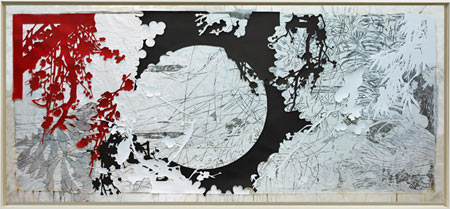
Best known for her complex installations that unfold their ideas in a bodily navigation of space and time, sculptor Judy Pfaff was originally a painter. That orientation has always shown in the deftness of her drawing, as has the draftsperson’s passion for direct physical sensation. Pfaff’s framed works tend toward the tactile and reject the idea of an image as necessarily something strictly two-dimensional. Instead, like her installations, her drawings and prints are constructed grounds accumulated more than rendered from tangible stuff made dynamic by the extensive hand labor that produces them.
These recent works on paper are seven-foot long, multi-layered collages that combine elements of woodblock print, loose mark making, hand painting and even digital imagery. Named “Year of the Dog,” for the Chinese Year in which the artist was born, Pfaff made one print for each of the 12 moons of the year, although only six are shown here. Each image is a panorama of negative and positive shapes, with most of the imagery drawn from nature.
“Year of the Dog #11” is a dense jungle of leaves and flowering or fruit-bearing branches. To navigate and make sense of the thick mat of vegetation, the eye searches for recognizable shapes. Those seem to just pop forward or slip quietly back because of the artist’s sensitive use of color, tone and form. Our eyes alight quickly on a floating white negative shape of a bird on a lacy limb. This sharp form delicately slips one cut edge behind a slightly grayer and more fully drawn fruiting branch. That pregnant shape, however, is elbowed aside by the strong ochre form of a collaged cut and glued sprig from a flowering cherry tree. While this playful battle for the foreground goes on, large areas of nuanced color, drawn line and shifting shapes in the background also seem to compel us horizontally across the long image. Pfaff makes that kind of visual motion an urge that feels physical. Her use of cut shapes, active line and paint that shifts from being a ground into a form then bleeds or falls off the edges, making the pictorial space so flexible that it feels both solid and amorphous.
“Year of the Dog #3” is a gray and black image of a verdant outpouring of leaves and marks on a painterly gray-washed ground. By stacking together sheets of paper with cut out shapes of limbs and abstract swirling lines the artist builds a tumbling mass suggestive of blowing leaves. To that jumble she adds a sweep of rich black crescents that echo the pile’s fall. But it is the way the artist also cuts into the washy ground so the eye sees past the gray and into the white backing page that makes the image really move. The sharp cut edges and their tangible penetration of the three-dimensional illusions on the surface knocks the whole thing into an added forward and back motion you can feel.
Pfaff makes drawings in preparation for and in advance of related installations. On these she works out the shapes, the logic and the structure of what is always essentially a bodily experience of the visual. To move through or around a Pfaff installation is to negotiate and peer through layers of sculptural elements whose lines, edges, colors, gaps, roundness, flatness and materials offer constantly shifting sights. Remarkably, her drawings are able to suggest that same kind of dynamic experience.
On “Year of the Dog #8” the artist stacks partial sheets of white, yellow, red and black painted paper into which which she has drawn or repeatedly cut out shapes of flowers, circles or leaves. Then she moves the cut elements around, or lightly folds them back, so that the large areas of bold, solid color tatter into almost abstract forms that are as much about the work of the hand as they are about nature. Pfaff’s cuts and folds are revelations. They are fragile openings with shallow shadows and precise edges that allow us to glimpse fractions of papers’ underlying colors and other fragments of drawing or shape. As we move along the work’s length the different openings read as windows. It’s like walking through a forest and looking past the shape of one limb to the strong shape of another, then focusing on towards a fragment of a mountain top framed by the trees but outlined against the sky. As we move the view constantly shifts with us.
Where some of Pfaff’s previous prints explored the sensation of vision penetrating into a structure’s form, the collage prints in this series make vision’s motion itself the active experience. She has a light touch with the paper she uses; cut edges curl seductively, excised silhouettes hang by a thread from their moorings and add real dimension to her line drawings. It’s a strong physical encounter with vision and materials that are also really smart.
Published courtesy of ArtScene ©2011
